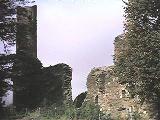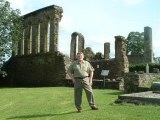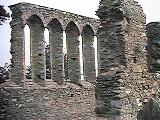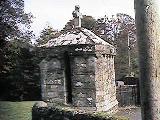Michael In Ireland Cyber Pub | home
Our New Parish Church



Irish Tatched Cottage

My Town

The Village/Town of Ferns is rich in History and of great beauty in the county of Wexford . The new parish church of St Aidan's contrasts with its ancient past











Ferns Cathedral was built in the 13th century. It was propably built by John St John, the first English bishop of Ferns who died in 1243 A.D. It stood within the boundary of the monastery founded by St Aidan in the sixth century. The remains of St Aidan (or Edan) who was also called St Mogue are buried beneath the Church. An inscription on the wall states that he died on Jan 31 632 A.D. The Cathedral was burned in 1575 and rebuilt in 1577 and there were many additions to it since then.
The first Christian settlement in Ferns was about 600 A.D. In 930 A.D. the monks were robbed by Viking raiders and the monastery was burned. In 1158 Dermot Mc Murrough founded an abbey in Ferns. St Mary's Abbey was suppressed in 1539 and the property reverted to the King of England. The abbey is probably located within the original enclosure of St Aidan.
In the cemetery, there are many high crosses. Part of a shaft with fret pattern decoration is said to mark the grave of Dermot Mc Murrough (died 1171), the deposed King of Leinster who invited the Normans to Ireland in 1169 A.D.
Ferns Castle (Wexford) 

The castle was built in the 13th century, possibly by William, Earl Marshall. Originally, the castle formed a square, with large corner towers. Only half of the castle now remains. The most complete tower contains a fine circular chapel, with carved ornament. The tower also has several original fireplaces and a vaulted basement. Archaeological excavations revealed a rock- cut ditch outside the castle walls.
Ferns Castle is one of a number of historic sites in Ferns. Others include St. Mary's, a 12th century Augustinian Priory; the remains of a 13th century cathedral, part of which is incorporated into the present Church of Ireland Church; St. Peter's, a small nave and chancel church; and some High Crosses and parts of crosses, which stand in the cathedral grounds.
Restricted access to castle for visitors with disabilities. Full access to visitor building.
St Aidan's Monastery .St Peter's Church built 16th Century.St Moling Well Died 697AD . St Aidans



To the north of the village are the ruins of St. Mary's Abbey, which was founded by Dermot MacMurrogh in 1158, St. Peters Church and St. Eden's Cathedral (Ferns Cathedral).
Within the cemetery there are four high crosses. The crosses have no inscriptions on them, tradition locally says that the head of Fr.John Murphy who was leader of the 1798 Rebellion is buried in the graveyard.
Also close by is St. Mogue's Well which is dedicated to St. Aidan. The waters of the well are thought to have curative properties. Towards the south of the village Ferns Castle is located. Tradition states that the castle is possibly built on the site of an earlier MacMurrogh stronghold.
In recent years excavation work has been carried out and has revealed a rock - cut fosse at the east and south of the castle. Also situated close by is St. Aidans Monastery of Adoration, which is built on the site of the old parish church, and the surrounding walls and piers are from the original church.
Wexford, a county in Leinster province, southeastern Ireland, has an area of 2,351 Ü (908 æ) and a population of 102,045 (1991). Enniscorthy, New Ross, and the county seat of Wexford are the major towns. Wexford consists of lowlands bordered by the Blackstairs Mountains in the west and by Saint George's Channel on the east and south. Cattle raising and the cultivation of cereals, wheat, and turnips are the main economic activities. The first part of Ireland to be invaded by Anglo-Normans in 1169, Wexford was subjugated by Oliver Cromwell in 1649. Wexford was one of the centers of the Irish rebellion of 1798.
Information on Ireland
Ireland, island, British Isles, the westernmost and second largest of the group, in the North Atlantic Ocean, and separated from Great Britain by Saint George's Channel on the southeast, the Irish Sea on the east, and the North Channel on the northeast. Politically, the island is divided into Northern Ireland, a constituent part of Great Britain, and the Republic of Ireland, formerly Eire. The island is divided into four historical provincesóConnaught (Connacht), Leinster, Munster, and Ulsteróand administrative units called counties. The Republic of Ireland consists of Connaught, Leinster, and Munster provinces, totaling 23 counties, and in the north, 3 counties of Ulster Province. Northern Ireland consists of 26 districts, the remainder of Ulster Province. The area of the island is 84,431 sq km (32,599 sq mi) (Republic of Ireland, 70,283 sq km/27,136 sq mi; Northern Ireland, 14,148 sq km/5463 sq mi). The population of the island (1981) is 4,925,364, including the Republic of Ireland (3,443,405).
In a northern and southern direction, the maximum length of Ireland is 486 km (302 mi); its extreme width is 280 km (174 mi). Malin Head, at latitude 55°27' north, and Mizen Head, at latitude 51°27' north, are, respectively, the northernmost and southernmost points on the island; easternmost and westernmost points are demarcated by longitude 5°25' west and longitude 10°30' west.
My Parish of Ferns Site http://www.ferns.ie/
-----------------------------------------------------------------------
North Wexford Tourism http://www.northwexford.com/ferns_castle.htm
-----------------------------------------------------------------------------------------------
About Wexford
County Wexford is situated in the South-Eastern corner of Ireland, often called the 'secret island', an unspoilt oasis in the sunniest part of the country. Over the years, Celts, Vikings and Normans came and settled here. Wexford was the first place the Normans landed when they invaded Ireland in 1169. The county has a combination of mountains, valleys, flora, fauna and breathtaking beaches spanning 200 km of coastline, dotted by resorts, scenic villages and pretty harbours.
Some of the best pubs, restaurants and hotels, as well as festivals and outdoor activities of all kinds are to be found here. Along with a rich cultural and archaeological heritage, this makes Wexford a very popular tourist destination.
Wexford Town was founded by the Vikings and developed by the Normans. It is an attractive town with many narrow streets and a long quayside. The town is well known for its famous annual Wexford Opera Festival.
Enniscorthy is a pleasant town overlooking the River Slaney about 20kms from Wexford town. The Norman Enniscorthy Castle contains the Wexford County Museum. The National 1798 Visitor Centre on Millpark Road, in the shadow of Vinegar Hill, is well worth a visit.